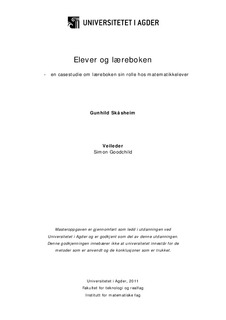| dc.description.abstract | Students and the textbook is a case study of the role of the textbook among students. When a
textbook is used in lessons, it is likely that a relation between the text and pupils will develop.
Then, it is reasonable to assume that the students are influenced by the textbook in one way or
the other. This study sets out to illustrate any relation that might exist between students
understanding and the way in which they use the textbook. I have attempted to identify what
is characteristic of each student’s understanding, although realizing the impossibility to
determine anyone’s perception with certainty. To classify the students understanding of
mathematics, I have used the theory and the concepts of Skemp (1976), instrumental and
relational understanding.
Research questions
What position do the textbook have in the class?
How do the students use the textbook?
Is there any relation between how students use the textbook and the nature of the
students understanding of mathematics?
Methods
The study builds on constructivist principles where the students build their own knowledge,
and learning is a result of how the students engage in different types of experience. I have
used qualitative methods to collect data. The data was collected by observing lessons, take
field notes, conduct a test, interview students and the teacher and taking photographs of the
workbooks of the students. The analysis was carried out by looking at the students’ activity
from several points of view with the intention of getting a broader and thus more secure
foundation for the interpretation.
Result
During the lessons, there were used no other resources than the textbook, or the material
associated with the textbook, for example a set of problems or the suggestions for solutions.
The lessons were structured and organized following the structure and organization of the
textbook, and the teacher based all the lessons on the texts in the textbook. The textbook had a
central and important position in the class. The students used the textbook in different ways.
Almost every student had his or her own, individual, way to use it. All of the students used the
answers to the tasks at the end of the textbook. The student’s use of the mathematical text in
the textbook, whether they gave it any attention or not, was the clearest difference between
how the students used the book. The identification of the nature of students understanding of
mathematics indicated that the students could show signs of both instrumental and relational
understanding, but that for each student one or other of the categories was more striking.
The evidence is not unequivocal, but indicated weak tendencies towards that the students who
mainly showed signs of relational understanding read the text in the textbook and used the
text, the formulas and then solved the tasks. The study also indicates that students who only
used the solved tasks and the formulas usually were students that showed to a greater extent
instrumental understanding. The weak relation between the textbook and students
understanding of mathematics is surprising because the students share to a considerable extent
the same experiences with mathematics. The study points out that it would be of interest to
examine further whether using the textbook in some ways are more effective than other ways. | en_US |
